


Cold neutrons and ultracold neutrons (UCNs) have been employed in a wide variety of investigations that shed light on important issues in nuclear, particle, and astrophysics in the determination of fundamental constants and in the study of fundamental symmetry violation. In many cases, these experiments provide information not available from existing accelerator-based nuclear physics facilities or high-energy accelerators.
The scientific issues addressed by most current and proposed experiments in cold-neutron fundamental physics can be placed into three categories as follows:
The first category involves the accurate determination of the parameters that describe neutron ß-decay (lifetime and correlation coefficients). Comparison of these results with nuclear and high-energy data can provide important information regarding the completeness of the three-family picture of the SM through a test of the unitarity of the CKM matrix. Neutron decay can be used to determine the CKM matrix element Vud with high precision in a fashion that is relatively free of theoretical uncertainties. We note that neutron decay is the only system that offers the prospective of a significant improvement in the direct determination of Vud. Such a measurement can be used to test whether the weak interaction in the charged-current sector is purely vector-axial vector (as in the SM) or has right-handed or other components. Neutron ß-decay also dictates the time scale for Big Bang Nucleosynthesis, and the neutron lifetime remains the most uncertain nuclear parameter in cosmological models that predict the cosmic 4He abundance.
The second category involves the study of the weak interaction between quarks in the strangeness-conserving sector. This study is difficult because of the overwhelming direct effects of the strong interaction. As a result, the effective weak couplings in the usual meson-exchange model of the process are poorly known. In fact, current experiments yield somewhat contradictory results for the dominant weak hadronic coupling fΠ. Sensitive experiments using polarized cold neutrons to determine parity violation (an unambiguous tag for the weak interaction) in the n-p, n-d, and n-α systems provide an opportunity to measure nucleon-nucleon (NN) weak interactions in simple systems that are not complicated by nuclear structure effects. Several different PNC experiments have been suggested: (1) measurement of the PNC gamma asymmetry in n+p→d+γ, (2) measurement of the PNC neutron spin rotation in liquid helium, (3) measurement of the PNC gamma asymmetry in n+d→t+γ, and (4) measurement of the PNC neutron spin rotation in liquid para-hydrogen. Because the observable in each of the above experiments depends upon a different linear combination of the π, ρ, and ω couplings, a determination of the complete set allows the extraction of not only fπ but also other couplings as well. Knowledge of these interactions is required to understand parity-violating phenomena in nuclei, such as the recently observed nuclear anapole moment, and can be used to gain information on quantum chromodynamics in the strongly interacting limit.
The third category, which lies at the heart of modern cosmology and particle physics, involves the search for the neutron electric dipole moment (EDM). Among the important issues that are addressed by this experiment are whether or not the baryon asymmetry of the universe is directly related to fundamental T-violation and whether or not the magnitude of T-violation is consistent with the predictions of the SM. In particular, Big Bang cosmology and the observed baryon asymmetry of the universe appear to require significantly more T-violation among quarks than is predicted by the SM. The next generation of neutron EDM searches will possess enough sensitivity to probe this issue.
Other experiments that can be conducted on FNPB include studies of parity and time reversal non-conservation, determination of fundamental constants, measurement of nuclear cross sections of interest to astrophysics, investigations involving matter wave interferometry, limits on the neutrality of matter, tests of baryon non-conservation, and others.
The capabilities of SNS provide for a reduction of background and minimization of magnetic interference, which have proven to be serious problems at other neutron facilities. SNS capabilities can reduce systematic errors in four main areas that relate to fundamental physics research:
Oak Ridge National Laboratory is managed by UT-Battelle LLC for the US Department of Energy